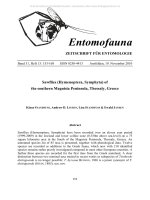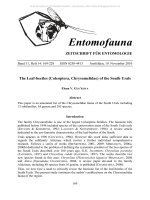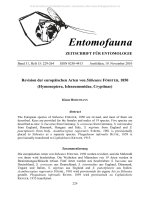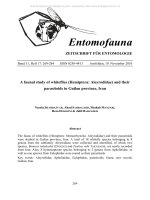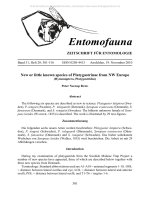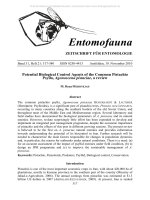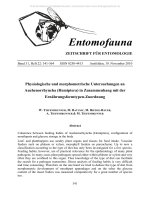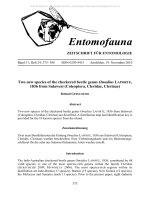Entomofauna, ZEITSCHRIFT FÜR ENTOMOLOGIE VOL 0028-0389-0404
Bạn đang xem bản rút gọn của tài liệu. Xem và tải ngay bản đầy đủ của tài liệu tại đây (1.3 MB, 16 trang )
©Entomofauna Ansfelden/Austria; download unter www.biologiezentrum.at
Entomofauna
ZEITSCHRIFT FÜR ENTOMOLOGIE
Band 28, Heft 29: 389-404
ISSN 0250-4413
Ansfelden, 30. November 2007
Ephialtini tribe (Hymenoptera, Ichneumonidae, Pimplinae) of
Turkish Thrace region
Murat YURTCAN
Abstract
In this study, specimens of Ephialtini (Hymenoptera: Ichneumonidae: Pimplinae)
collected from a total of 75 localities dispersed over 8 different habitats of Turkish
Thrace region between the years 1992 and 2002, were evaluated and a total of 23 species
were identified. Of these, 5 species are new records for the Turkish fauna. Furthermore,
collection periods and beneficial notes on habitats and zoogeographies for each species
were given. Among the identified species, Scambus rufator AUBERT 1964 and Perithous
romanicus CONSTANTINEANU & CONSTANTINEANU 1968 have a Europeo-Mediterranean
chorotype. On the other hand, whereas Sibero-European is represented by only 1 species,
2 species have Asiatic-European, 2 species have Westpalearctic, 6 species have
Holoarctic and 3 species have Palearctic chorotypes. The rest 7 species are the ones that
show multiregional distribution. Exeristes roborator (FABRICIUS, 1793), Zaglyptus
multicolor (GRAVENHORST 1829) and Z. varipes (GRAVENHORST 1829) are the most
common species in Turkish Thrace region. These three species show a wide ranged
distribution and occur in different habitats throughout the research area and were
considered to be eurytolerant in terms of their habitat preference.
Key words: Zoogeography, Habitat Preference, Turkish Thrace, Ichneumonidae, Ephialtini.
389
©Entomofauna Ansfelden/Austria; download unter www.biologiezentrum.at
Zusammenfassung
Vorliegende Arbeit behandelt türkische Ephialtini (Hymenoptera: Ichneumonidae:
Pimplinae) aus der Region Thrace, die im Zeitraum 1992 bis 2002 an 75 verschiedenen
Orten und acht unterschiedlichen Habitaten gesammelt wurden. Daraus ergaben sich 23
verschiedene Arten, die folgenden 5 davon sind neu für die Türkei: Scambus vesicarius
(RATZEBURG 1844), Perithous romanicus CONSTANTINEANU & CONSTANTINEANU 1968,
Gregopimpla inquisitor (SCOPOLI 1763), Tromatobia ovivora (BOHEMAN 1821) und
Clistopyga rufator HOLMGREN 1856. Die Verbreitungstypen der einzelnen Taxa wurden
festgehalten.
Introduction
Ichneumonidae is the largest family of the Hymenoptera with at least 60.000 species
recorded worldwide (TOWNES 1969). Among this family, about 1.490 species found all
over the world constitute the Pimplinae subfamily, of which 330 have been recorded
throughout the Palearctic region (YU & HORSTMAN 1997). Ephialtini, whose members
are ectoparasitoids of immature Coleoptera, Diptera, Hymenoptera, Lepidoptera, Neuroptera and Araneida, is one of the largest tribe of Pimplinae (KASPARYAN 1981; FITTON
et al. 1987, 1988; GAULD & BOLTON 1988; WAHL 1993; SHAW 1998; GÜLTEKIN et al.
2004; FINCH 2005; YU et al. 2006).
The earliest studies on Turkish Ephialtini fauna were carried out by KOHL (1905) and
FAHRINGER (1922). KOLAROV (1995) reviewed studies performed until then in Turkish
Ichneumonidae catalog. Similar valuable projects continued to be done including
Ephialtini records (KOLAROV & BEYARSLAN 1994, KOLAROV et al. 1997a, 1997b, 1999,
2002, ÇORUH et al. 2002, KASPARYAN & GÜLTEKIN, 2002, KOLAROV & GÜRBÜZ 2004,
GÜRBÜZ & AKSOYLAR 2005). A total of 47 Ephialtini species have been recorded so far
with these studies.
This study was carried on in 75 localities in Turkish Thrace Region between the years
1992 and 2002 (Fig. 1, Tab. 1).
Our study area, Turkish Thrace, extends over 23.485 km2 with deciduous and coniferous
forests covering 20 % of the region. These forests are mainly situated on the Ganos and
Koru Mountains in the southern and on the Istranca Mountains in the northern part of the
region. The rest of the study area is meadows (20 %) and cultivated land (60 %).
Ganos and Istranca mountains are heavily forested areas in the region. Ganos Mountains
are generally constituted of Eosen-Oligosen masses. It lies in NE-SE direction and its
highest point is 920 m. Istranca Mountains, located in the north, did not undergo a glacier
stage in Pleistosene and its highest point is 1081 m. Ganos and Istranca Mountains have
been partly protected against human settling since its topographic structure is unsuitable
for agricultural cultivation.
With the present study, aiming to aid in the identification and understanding of the Turkish Ephialtini, their distributions and habitat preferences, chorotype and habitat preference tables were prepared and discussed (Tab. 2-3). It is also the first extensive study on
the subject in the region. New records for Turkey and Turkish Thrace faunas were given
with asterisk (*) and plus (+), respectively.
390
©Entomofauna Ansfelden/Austria; download unter www.biologiezentrum.at
Fig. 1: Studied localities throughout the Turkish Thrace region.
Tab. 1: Locality and habitats of Turkish Thrace Ephialtini.
Localities no
Localities
Habitat
1
Edirne-Uzunköprü-Saçlımüsellim
2
İstanbul-Çatalca-Binkılıç
Pasture
3
İstanbul-Silivri-Küçüksinekli
Pasture
4
Çanakkale-Gelibolu
Pasture
5
Edirne-Tavuk Ormanı
Mix forest
6
Edirne-Lalapaşa-Vaysal
Oak forest
7
Kırklareli-Pınarhisar-Yenice
Oak forest
8
Kırklareli-Demirköy-İğneada
Mix forest
9
Kırklareli-Dereköy
Oak forest
10
Kırklareli-Dereköy-Çağalayık
Oak forest
391
Oak forest
©Entomofauna Ansfelden/Austria; download unter www.biologiezentrum.at
Localities no
11
Localities
Kırklareli-Kofçaz-Aşağıkanara
Habitat
Oak forest
Orchards
12
Edirne-Hadımağa
13
Kırklareli-Babaeski-Alpullu
Pasture
14
Edirne-Havsa-Çukurköy
Pasture
15
Edirne-Meriç-Küplü
Pasture
16
Edirne-Meriç-Paşayenice
Pasture
17
Kırklareli-Pınarhisar-Sütlüce
Willow and poplar woodlands
18
Kırklareli-Vize
19
Tekirdağ-Saray
Oak forest
20
Kırklareli-Vize-Kömürköy
Willow and poplar woodlands
21
Tekirdağ-Çerkezköy
Oak forest
22
İstanbul-Sarıyer-Bilezikçi Çiftliği
Mix forest
23
Tekirdağ-Muratlı-Aşağısevindikli
Willow and poplar woodlands
24
İstanbul-Kısırmandıra
Mix forest
25
Tekirdağ-Ferhadanlı
Willow and poplar woodlands
26
Tekirdağ-Hayrabolu-Kandamış
Willow and poplar woodlands
27
Tekirdağ-Malkara
Willow and poplar woodlands
28
Çanakkale-Gelibolu-Evreşe
Willow and poplar woodlands
29
Tekirdağ-Şarköy-Güzelköy
30
Edirne-Enez
Pine forest
31
Edirne-Keşan-Korudağı
Pine forest
32
Edirne-İpsala
Clover fields
33
Tekirdağ-Malkara-Tekkeköy
Willow and poplar woodlands
34
Edirne-Keşan-Karahisar
Pasture
35
Tekirdağ-Hayrabolu-Susuzmüsellim
Crop fields
36
Tekirdağ-Saray-Beyazköy
Pasture
37
Tekirdağ-Çorlu-Marmara Ereğlisi
Pasture
38
Kırklareli-Lüleburgaz-Türkgeldi
D.Ü.Çiftliği
Orchards
39
Edirne-Lalapaşa-Doğanköy
Oak forest
40
Edirne-Lalapaşa-Uzunbayır
Clover fields
41
Edirne-Suakacağı
Willow and poplar woodlands
42
Kırklareli-Demirköy
Mix forest
43
Kırklareli-Demirköy-Balaban
Mix forest
44
Edirne-Meriç-Subaşı
Pasture
Pasture
Willow and poplar woodlands
Pasture
392
Willow and poplar woodlands
Oak forest
©Entomofauna Ansfelden/Austria; download unter www.biologiezentrum.at
Localities no
Localities
Habitat
45
Tekirdağ-Muratlı
46
Tekirdağ- Ganos-Radar
Willow and poplar woodlands
Oak forest
47
Tekirdağ-Uçmakdere
Orchards
48
Tekirdağ-Işıklar
Oak forest
49
Kırklareli-Dereköy-Gümrük
Mix forest
50
Kırklareli-Lüleburgaz-Ceylanköy
Pasture
51
Tekirdağ-Hayrabolu-Lahana
Clover fields
52
Tekirdağ-Yazırköy
Orchards
53
Çanakkale-Gelibolu-Fındıklı
Pasture
54
Çanakkale-Eceabat-Ilgardere
Orchards
55
İstanbul-Çatalca-Ömerli
Willow and poplar woodlands
56
İstanbul-Silivri-Büyükkılıçlı
Willow and poplar woodlands
57
Kırklareli-Vize-Kıyıköy
Willow and poplar woodlands
58
Kırklareli-Kofçaz-Ahmetler
Oak forest
59
Kırklareli-Kofçaz-Beyci
Willow and poplar woodlands
60
Kırklareli-Lüleburgaz-Çengelli
Willow and poplar woodlands
61
Kırklareli-Lüleburgaz-Emirali
Willow and poplar woodlands
62
Kırklareli-Seyitler
Willow and poplar woodlands
63
Edirne-Meriç-Akçadam
Willow and poplar woodlands
64
Edirne-Enez-Hasköy
Willow and poplar woodlands
65
Edirne-İpsala-Kocahıdır
Willow and poplar woodlands
66
Edirne-Keşan-Barağı
Willow and poplar woodlands
67
Tekirdağ-Naip
Pasture
68
Edirne-U.köprü-Balabankoru
Willow and poplar woodlands
69
Edirne-U.köprü-Çöpköy
Clover fields
70
Edirne-U.köprü-Karapınar
Willow and poplar woodlands
71
İstanbul-G.paşa-Boğazköy
Orchards
72
İstanbul-Silivri-Akören
Pasture
73
İstanbul-Silivri-Ortaköy
Orchards
74
Tekirdağ-Hayrabolu
Willow and poplar woodlands
75
Tekirdağ-Malkara-Çınarlıdere
Willow and poplar woodlands
393
©Entomofauna Ansfelden/Austria; download unter www.biologiezentrum.at
Material and Methods
Adult specimens of Ephialtini were collected from pastures, willow and poplar woodlands, clover and crop fields, orchards, pine, oak and mixed forests at different altitudes
in Turkish Thrace between the years 1992 and 2002. A sweeping-net was used for diurnal specimens while a light trap was used for nocturnal species. The specimens were
compared with relevant literature data, material from Bulgaria previously collected and
identified by Dr J. Kolarov and with specimens stored at the Hungarian Natural History
Museum. Taxonomical analyses employed methods described in earlier papers (TOWNES
1969, KASPARYAN 1981, FITTON et al. 1988, KOLAROV 1997). We followed YU et al.
(2006) for general distributions of the species. The study material is kept at the Biology
Department of Trakya University (TU).
Results
+Exeristes arundinis (KRIECHBAUMER 1887)
M a t e r i a l e x a m i n e d : 35: (110m), 15.08.1995, 1&; 37: (20m), 07.08.1995, 1(.
G e n e r a l D i s t r i b u t i o n : Eastern Palearctic, Europe, Western Palearctic.
Exeristes roborator (FABRICIUS 1793)
M a t e r i a l e x a m i n e d : 2: (200m), 03.10.1992, 1&; 12: (41m), 09.10.2001, 1(; 29:
(400m), 08.09.1999, 1(; 24.08.2000, 2&&; 30: (15m), 27.06.1993, 2((; 34: (180m),
06.08.1993, 1&; 40: (200m), 05.07.1997, 2((; 44: (50m), 13.09.1997, 2((; 45: (54m),
07.09.1999, 1&, 2((; 52: (60m), 23.08.2000, 1&, 2((; 55: (80m), 15.06.2001, 1&; 60:
(60m), 18.07.2001, 2&&; 68: (15m), 13.07.2002, 1&.
G e n e r a l D i s t r i b u t i o n : Eastern Palearctic, Ethiopian, Europe, Oriental,
Western Palearctic.
Fredegunda diluta (RATZEBURG 1852)
M a t e r i a l e x a m i n e d : 29: (400m), 22.06.1995, 1&; 56: (150m), 15.06.2001, 1&, 1(.
G e n e r a l D i s t r i b u t i o n : Europe, Western Palearctic.
+Endromopoda arundinator (FABRICIUS 1804)
M a t e r i a l e x a m i n e d : 4: (10m), 06.05.1993, 1&; 32: (70m), 05.08.1993, 1&; 45:
(54m), 07.09.1999, 1&; 54: (20m), 08.06.2001, 1&; 68: (15m), 13.07.2002, 1(; 69: (60m),
13.07.2002, 1&.
G e n e r a l D i s t r i b u t i o n : Eastern Palearctic, Europe, Western Palearctic.
394
©Entomofauna Ansfelden/Austria; download unter www.biologiezentrum.at
Endromopoda detrita (HOLMGREN 1860)
M a t e r i a l e x a m i n e d : 7: (700m), 19.07.1994, 1(; 9: (400m), 17.07.2001, 1(; 17:
(110m), 22.06.1993, 2&&; 19: (150m), 16.06.2001, 3&&; 20: (180m), 23.06.1993, 1&;
21: (110m), 23.06.1993, 1&; 23: (90m), 24.06.1993, 2&&; 26: (70m), 25.06.1993, 1&; 28:
(20m), 26.06.1993, 1&; 29: (400m), 08.09.1999, 1&; 43: (400m), 06.07.1997, 1&, 1(; 47:
(300m), 24.08.2000, 1&; 48: (110m), 25.08.2000, 1&; 59: (170m), 17.07.2001, 1(; 61:
(60m), 18.07.2001, 1&; 63: (85m), 27.07.2001, 1&; 13.07.2002, 1&; 64: (80m),
02.08.2001, 1&, 1(; 68: (15m), 13.07.2002, 1&; 71: (60m), 14.07.2002, 1(; 72: (15m),
14.07.2002, 1&, 2((.
G e n e r a l D i s t r i b u t i o n : Eastern Palearctic, Europe, Nearctic, Oriental,
Western Palearctic.
+Endromopoda phragmitidis (PERKINS 1957)
M a t e r i a l e x a m i n e d : 10: (620m), 17.07.2001, 1&; 18: (150m), 25.07.2000, 1&; 19:
(150m.), 16.06.2001, 1&; 38: (60m), 03.08.1996, 1&; 45: (54m), 07.09.1999, 1&; 52:
(60m), 23.8.2000, 1&; 63: (85m), 27.07.2001, 6&&; 68(15m), 13.07.2002, 1&; 70: (50m),
13.07.2002, 1&; 72: (15m), 14.07.2002, 1&.
G e n e r a l D i s t r i b u t i o n : Eastern Palearctic, Europe, Western Palearctic.
Scambus brevicornis (GRAVENHORST 1829)
M a t e r i a l e x a m i n e d : 7: (700m), 19.07.1994, 1&, 1(; 04.10.1999, 1&; 12: (41m),
25.10.2001, 1&; 20: (180m), 23.06.1993, 1(; 26: (70m), 25.06.1993, 1&; 39: (370m),
24.09.1998, 1&; 42: (390m), 15.09.1999, 1&; 46: (700m), 08.09.1999, 1&; 24.08.2000,
1&; 48: (110m), 23.10.2001, 3&&; 67: (30m), 23.10.2001, 1&.
G e n e r a l D i s t r i b u t i o n : Holarctic.
+Scambus calobatus (GRAVENHORST 1829)
M a t e r i a l e x a m i n e d : 3: (170m), 03.10.1992, 1&; 24: (70m), 25.06.1993, 1(; 41:
(55m), 05.07.1997, 1(.
G e n e r a l D i s t r i b u t i o n : Eastern Palearctic, Europe, Western Palearctic.
+Scambus elegans (WOLDSTEDT 1877)
M a t e r i a l e x a m i n e d : 53: (40m), 07.06.2001, 1&.
G e n e r a l D i s t r i b u t i o n : Eastern Palearctic, Europe, Western Palearctic.
+Scambus foliae (CUSHMAN 1938)
M a t e r i a l e x a m i n e d : 75: (210m), 26.07.2000, 1(.
G e n e r a l D i s t r i b u t i o n : Europe, Western Palearctic.
395
©Entomofauna Ansfelden/Austria; download unter www.biologiezentrum.at
+Scambus nigricans (THOMSON 1877)
M a t e r i a l e x a m i n e d : 5: (40m), 07.05.2002, 1&; 9: (400m), 17.07.2001, 1(; 18:
(150m), 25.07.2000, 1&; 22: (30m), 16.06.2001, 1&; 25: (150m), 25.06.1993, 1(; 26:
(70m), 25.06.1993, 1(; 33: (170m), 05.08.1993, 1&; 35: (110m), 06.08.1993, 1&;
43:(400m), 06.07.1997, 1(; 65: (90m), 02.08.2001, 1&; 72: (15m), 14.07.2002, 1&; 74:
(40m), 19.06.1993, 1&.
G e n e r a l D i s t r i b u t i o n : Holarctic.
Scambus rufator AUBERT 1964
M a t e r i a l e x a m i n e d : 42: (390m), 15.09.1999, 1&.
G e n e r a l D i s t r i b u t i o n : Europe, Western Palearctic.
*Scambus vesicarius (RATZEBURG 1844)
M a t e r i a l e x a m i n e d : 6: (380m), 29.05.1993, 1&; 14: (30m), 19.06.1993, 1&; 19:
(150m), 22.06.1993, 1&; 62: (65m), 18.07.2001, 1&.
G e n e r a l D i s t r i b u t i o n : Holarctic.
+Ephialtes manifestator (LINNAEUS 1758)
M a t e r i a l e x a m i n e d : 8: (10m), 19.07.1994, 1&.
G e n e r a l D i s t r i b u t i o n : Eastern Palearctic, Europe, Nearctic, Oriental,
Western Palearctic.
*Perithous romanicus CONSTANTINEANU & CONSTANTINEANU 1968
M a t e r i a l e x a m i n e d : 52: (60m), 23.8.2000, 1&.
G e n e r a l D i s t r i b u t i o n : Europe, Western Palearctic (Bulgaria, Romania and
Turkey).
Perithous divinator (ROSSI 1790)
M a t e r i a l e x a m i n e d : 12: (41m), 12.10.1999 (Nocturnal), 1&; 13.07.2002, 1(; 29:
(400m), 08.09.1999, 1&; 47: (300m), 24.08.2000, 1(; 63: (85m), 27.07.2001, 1(.
G e n e r a l D i s t r i b u t i o n : Eastern Palearctic, Europe, Nearctic, Oriental,
Western Palearctic.
*Gregopimpla inquisitor (SCOPOLI 1763)
M a t e r i a l e x a m i n e d : 13: (40m), 18.06.1993, 1(; 15: (50m), 21.06.1993, 1(; 20:
(180m), 23.06.1993, 2((; 23: (90m), 24.06.1993, 1(; 25: (150m), 25.06.1993, 2((; 26:
(70m), 25.06.1993, 2((; 27: (220m), 25.06.1993, 2((; 29: (400m), 26.06.1993, 2((.
G e n e r a l D i s t r i b u t i o n : Holarctic.
396
©Entomofauna Ansfelden/Austria; download unter www.biologiezentrum.at
Tromatobia ornata (GRAVENHORST 1829)
M a t e r i a l e x a m i n e d : 5: (40m), 22.05.1993, 1&; 48: (110m), 25.08.2000, 1(; 61:
(60m), 18.07.2001, 1&.
General
Palearctic.
D i s t r i b u t i o n : Eastern Palearctic, Europe, Oriental, Western
*Tromatobia ovivora (BOHEMAN 1821)
M a t e r i a l e x a m i n e d : 11: (450m), 20.06.1994, 1&.
G e n e r a l D i s t r i b u t i o n : Eastern Palearctic, Europe, Nearctic, Neotropic,
Oceanic, Western Palearctic.
+Tromatobia variabilis (HOLMGREN 1856)
M a t e r i a l e x a m i n e d : 1: (100m), 01.08.1992, 1(; 32: (70m), 27.07.2000, 1&; 50:
(60m), 25.07.2000, 1(; 51: (70m), 26.07.2000, 1(; 56: (150m), 15.06.2001, 1&; 73:
(50m), 14.07.2002, 1(.
G e n e r a l D i s t r i b u t i o n : Holarctic.
Zaglyptus multicolor (GRAVENHORST 1829)
M a t e r i a l e x a m i n e d : 5: (40m), 07.05.2002, 1&; 15: (50m), 21.06.1993, 1(; 31:
(350m), 09.09.1999, 1&; 47: (300m), 08.09.1999, 1(; 48: (110m), 09.09.1999, 2&&;
25.08.2000, 1(; 66: (85m), 02.08.2001, 1&, 2((.
General
Palearctic.
D i s t r i b u t i o n : Eastern Palearctic, Europe, Oriental, Western
Zaglyptus varipes (GRAVENHORST 1829)
M a t e r i a l e x a m i n e d : 9: (400m), 05.06.1993, 1&; 12: (41m), 09.10.2001, 2&&,
3((; 16: (60m), 21.06.1993, 1&; 32: (70m), 05.08.1993, 1(; 36: (85m), 12.08.1993, 1&;
38: (60m), 25.07.2002, 1&; 45: (54m), 07.09.1999, 1(; 46: (700m), 08.09.1999, 1(; 48:
(110m), 24.8.2000, 1&49: (430m), 23.07.2000, 1(; 57: (15m), 16.06.2001, 1(; 58:
(570m), 17.07.2001, 2&&; 61: (60m), 17.07.2001, 1(.
G e n e r a l D i s t r i b u t i o n : Holarctic.
*Clistopyga rufator HOLMGREN 1856
M a t e r i a l e x a m i n e d : 12: (41m), 09.10.2001, 1&; 25.10.2001, 1&.
G e n e r a l D i s t r i b u t i o n : Eastern Palearctic, Europe, Western Palearctic.
397
©Entomofauna Ansfelden/Austria; download unter www.biologiezentrum.at
Tab. 2: Chorotypes of Turkish Thrace Ephialtini
Holarctic
Scambus brevicornis
Scambus nigricans
Scambus vesicarius
Gregopimpla inquisitor
Tromatobia variabilis
Zaglyptus varipes
Palearctic
Endromopoda arundinator
Endromopoda phragmitidis
Scambus calobatus
West-Palearctic
Fredegunda diluta
Scambus elegans
Asiatic-European
Exeristes arundinis
Clistopyga rufator
Sibero-European
Scambus foliae
Europeo-Mediterranean
Scambus rufator
Perithous romanicus
willow and
poplar
woodlands
Pine Forest
Clover fields
+
+
+
+
+
Fredegunda diluta
+
Endromopoda arundinator
+
Endromopoda detrita
+
Endromopoda phragmitidis
+
Scambus brevicornis
+
+
Scambus calobatus
+
+
Scambus elegans
+
+
+
+
+
+
+
+
+
+
+
5
4
+
4
+
4
3
1
+
+
2
6
2
+
Scambus foliae
Scambus nigricans
+
Total
Orchards
+
+
+
Crop Fields
Oak forest
Exeristes arundinis
Exeristes roborator
Mix forest
Habitat
Species
Pasture
Tab. 3: Habitat preference of Turkish Ephialtini.
+
+
398
+
1
+
5
Scambus rufator
Scambus vesicarius
+
+
Ephialtes manifestator
+
1
3
+
+
1
Perithous romanicus
+
Perithous divinator
+
Gregopimpla inquisitor
+
Tromatobia ornata
+
+
+
+
Tromatobia ovivora
1
+
4
+
2
+
3
+
Tromatobia variabilis
+
Zaglyptus multicolor
+
Zaglyptus varipes
+
Clistopyga rufator
+
Total numbers of species
for each habitat
16
Total
Crop Fields
Clover fields
Pine Forest
willow and
poplar
woodlands
Orchards
Oak forest
Mix forest
Habitat
Species
Pasture
©Entomofauna Ansfelden/Austria; download unter www.biologiezentrum.at
1
+
+
+
+
+
+
+
+
+
+
+
+
5
+
6
+
6
1
9
13
9
16
5
4
2
Discussion
Among the species determined with this study, Scambus vesicarius, Perithous
romanicus, Gregopimpla inquisitor, Tromatobia ovivora and Clistopyga rufator are new
records for Turkey fauna. So, number of Ephialtini species in Turkey was increased to
52. Exeristes arundinis, Endromopoda arundinator, E. phragmitidis, Scambus calobatus,
S. elegans, S. foliae, S. nigricans, Ephialtes manifestator, T. ornata and T. variabilis are
new records for Turkish Thrace.
8 different habitats in Turkish Thrace were investigated during the study (Tab. 3). The
most preferred habitats are willow and poplar woodlands and pasture with 16 species for
each, followed by oak forest with 13 species. Arid conditions in Turkish Thrace following June cause Ephialtini species to be present in willow and poplar woodlands localized along humid regions and in pasture. The least preferred habitat is crop field with only
2 species. This preference pattern can be thought to be due to host distributions and food
preference.
Exeristes roborator, Zaglyptus multicolor and Z. varipes are the most common species in
Turkish Thrace region with their presence in 6 different habitats. These three species
show a wide ranged distribution and occur in different habitats throughout the research
area. They were considered to be eurytolerant in terms of their habitat preference. As
399
©Entomofauna Ansfelden/Austria; download unter www.biologiezentrum.at
they are commonly found in Palearctic region and in neighboring countries of Turkey,
their presence in Turkish Thrace is an expected situation.
The Istranca Mountains to the north and the Ganos and Koru Mountains to the south of
the research area are covered with natural forests. With this study, 11 species from
Istranca Mountains and 12 species from Ganos Mountains were determined. The rich
species numbers here depend on the natural forest structure, seldom or even lack of
agricultural fields and thus on lack of agricultural chemical applications. Scambus
rufator Perithous romanicus, Ephialtes manifestator, Tromatobia ovivora were only
determined in forest areas in Istranca and Ganos Mountains. It is reasonable to consider
these species as to be arboreal in terms of their habitat preference. S. elegans was found
only in maguis-pseudomaguis while Exeristes arundinis and Endromopoda arundinator
were found in both maguis-pseudomaguis and anthropogenic steppe areas. On the other
hand, Clistopyga rufator is a species found only in anthropogenic steppe areas.
Light traps were used to obtain nocturnal specimens and only one specimen of Perithous
divinator from only one locality was catched. Despite this, Ephialtini species shouldn’t
be regarded as to possess a nocturnal habit because this only 1 specimen most probably
was catched just by chance.
Many scientists interested in biogeography proposed and used the term "chorotype" by
grouping geographical distributions of plants and animals. TAGLIANTI et al. (1999) devided Holarctic region into 13 chorotypes. Our present species were grouped according to
this classification and the corresponding chorotypes for each species were given in Tab.
2. Among the 6 chrotypes for the specimens collected in the research area, Holarctic and
Palearctic chorotypes were represented with the highest species numbers; 6 species for
Holarctic and 3 species for Palearctic. Seven species with multiregional distributions
were not included. Among these seven species, Tromatobia ornata and Zaglyptus
multicolor show distribution in Oriental region and Exeristes roborator show distribution
in Etiopian and Oriental regions in addition to Palearctic region. Similarly,
Endromopoda detrita, Ephialtes manifestator and Perithous divinator show distribution
in Oriental region and T. ovivora shows distribution in Oceanic and Neotropic regions in
addition to Holarctic region. This wide range distribution is due to rich host availabilities
of the species besides their eurytolerant nature (KASPARYAN 1981, YU et al. 2006).
Clistopyga rufator from the Asiatic- Europan chorotype was determined in our research
area and so its southern range of distribution was expanded. Turkey is also the southern
border for distribution range of Fredegunda diluta from West-Palearctic chorotype.
Scambus rufator has a Europeo-Mediterranean chorotype with its eastern border of distribution range being Turkey and it doesn’t occur further in the east of Turkey. Another
Europeo-Mediterranean chorotype, Perithous romanicus, has so far been determined
from only Romania and Bulgaria. Its presence in our research area shows that this species is a Balkan subendemic.
Determination of Exeristes arundinis, Scambus rufator, S. elegans, S. foliae, Perithous
romanicus, Fredegunda diluta and Clistopyga rufator, all occurring rarely in Palearctic,
in a geographically small area as Turkish Thrace is an important point showing biological diversity of Turkey.
400
©Entomofauna Ansfelden/Austria; download unter www.biologiezentrum.at
Acknowledgements
This study is a part of PhD’s thesis accepted on 01.03.2004 by Trakya University Institute of
Science. I thank to Prof. Dr. Ahmet Beyarslan who served as my supervisor for the study. I also
thank to Dr. Kolarov for checking some identified material and kindly lending his collection material for comparisons and to Dr. Zombori for comparison material he let us to use in Budapest Natural History Museum.
References
ÇORUH S., ÖZBEK H. & J. KOLAROV (2002): New and rare taxa of Ichneumonidae
(Hymenoptera) from Turkey. – Journal of the Entomological Research Society 4 (1): 1-4.
FAHRINGER J. (1922): Hymenopterologische Ergebnisse einer wissenschaftlichen Studienreise
nach der Türkei und Kleinasien (mit Ausschluß des Amanusgebirges). – Archiv für
Naturgeschichte A88 (9): 149-222.
FINCH O.D. (2005): The parasitoid complex and parasitoid-induced mortality of spiders
(Araneae) in a Central European woodland. – Journal of Natural History 39 (25): 23392354.
FITTON M.G., SHAW M.R. & A.D. AUSTIN (1987): The Hymenoptera Associated With Spiders
in Europe. – Zoological Journal of the Linnean Society 90: 63-93.
FITTON M.G., SHAW M.R. & I.D. GAULD (1988): Pimpline Ichneumon-Flies, Hymenoptera,
Ichneumonidae (Pimplinae), Handbooks for the Identification of British Insects. – Royal
Entomological Society of London 7 (1): 1-110.
GAULD I.D. & B. BOLTON (1988): The Hymenoptera, British Museum (Natural History). –
Oxford University Press, New York, United States, 332 pp.
GÜLTEKIN L., ZENGIN H. & R. HAYAT (2004): Life history of Lixus bardanae on Curly dock
(Rumex crispus) in Turkey. – Phytoparasitica 32 (1): 97-99.
GÜRBÜZ M.F. & M.Y. AKSOYLAR (2005): New records of Ichneumonidae (Hymenoptera)
species from Turkey. – Phytoparasitica 33 (2): 121-122.
KASPARYAN D.R. (1981): Opredelitel Nasekomich Europeiskoy Casti U.S.S.R. III. Part, –
Prepontchatokrilie 3: 1-688. (In Russian.)
KASPARYAN D.R. & L. GÜLTEKIN (2002): First records of two ichneumonid wasps from
northeastern Turkey (Hymenoptera: Ichneumonidae). – Zoosystematica Rossica 11 (1):
218.
KOHL F.F. (1905): Hymenopteren. – In: PENTHER A. & E. ZEDERBAUER (eds), Ergebnisse
einer naturwissenschaftlichen Reise zur Erdschias-Dagh (Kleinasien). – Annalen des
Naturhistorischen Museum in Wien 20: 220-246.
KOLAROV J.A. (1995): A catalogue of the Turkish Ichneumonidae (Hymenoptera). –
Entomofauna 16 (7): 137-188.
KOLAROV J.A. (1997): Fauna and Zoogeography of the Balkan Peninsula Pimplini
(Hymenoptera, Ichneumonidae). I Genus Apechtis FOERSTER. – Annuaire de
l’Universite de Sofia "St. Kliment Ohridski" 88 (4): 114-118. (Bulgarian, with English
key).
KOLAROV J.A. & A. BEYARSLAN (1994): Investigations on the Ichneumonidae (Hymenoptera)
fauna of Turkey I Pimplinae and Tryphoninae. – Türkiye Entomoloji Dergisi 18 (3):
133-140.
401
©Entomofauna Ansfelden/Austria; download unter www.biologiezentrum.at
KOLAROV J. & M.F. GÜRBÜZ (2004): A study of the Turkish Ichneumonidae (Hymenoptera).
I. Pimplinae. – Linzer biologische Beiträge 36 (2): 841-845.
KOLAROV J., BEYARSLAN A. & M. YURTCAN (1997a): Ichneumonidae (Hymenoptera) from
the Gokceada and Bozcaada Islands – Turkey. – Acta Entomologica Bulgarica 3-4: 1315.
KOLAROV J., ÖZBEK H. & E. YILDIRIM (1999): New distributional data of the Turkish
Ichneumonidae (Hymenoptera). I Pimplinae and Tryphoninae, – Journal of the
Entomological Research Society 1 (2): 9-15.
KOLAROV J., YURTCAN M. & A. BEYARSLAN (1997b): New and rare Ichneumonidae
(Hymenoptera) from Turkey. I. Pimplinae, Tryphoninae, Phygadeuontinae, Banchinae
and Ctenopelmatinae. – Acta Entomologica Bulgarica 3-4: 10-12.
KOLAROV J., YURTCAN M. & A. BEYARSLAN (2002): Ichneumonidae species of the Turkish
Aegean Region. – In: MELIKA G. & C. THUROCZY (eds), Parasitic wasps: evolution,
systematics, biodiversity and biological control, International Symposium 14-17. May.
2001: 299-305. – Agroinform, Koszeg-Hungary, 480 pp.
SHAW M.R. (1998): Hymenopteres europeens en particulier les Polysphinctini don’t les larves
se nourrissent d’araignees, pp. 14-40. – In: V. CHANSIGAUD (Ed.), Les Insectes parasites
des cocoons d’Araignees. Connaissance des Invertabres serie Arachnides 3, 56 pp.
TAGLIANTI V.A., AUDISIO P.A., BIONDI M., BOLOGNA M.A., CARPANETO G.M., De BIASE A.,
FATTORINI S., PIATTELLA E., SINDACO R., VENCHI A. & M. ZAPPAROLI (1999): A
proposal for a chorotype classificatioın of the Near East fauna, in the framework of the
Western Palearctic region. – Biogeographia 20: 31-59.
TOWNES H. (1969): The Genera of Ichneumonidae Part I. – Memoirs of the American
Entomological Institute 11: 1-300.
WAHL B.D. (1993): Family Ichneumonidae, pp. 395-509. – In: GOULET H. & J.T. HUBER
(Eds), Hymenoptera of the World: an identification guide to families, – Research
Branch Agriculture Canada Publication 1894/E, Ottawa, Canada. 668 pp.
YU D.S. & K. HORSTMANN (1997): Catalogue of World Ichneumonidae (Hymenoptera). –
Memoirs of the American Entomological Institute 58 (1-2): 1-1558.
YU D.S., ACHTERBERG C. & K. HORSTMANN (2006): Interactive Catalogue of World
Ichneumonoidea, Taxonomy, biology, morphology and distribution, Compact disc
(Master version). – Taxapad, Canada.
Address of the author:
Murat YURTCAN
Trakya University, Faculty of Arts and Science
Department of Biology, Edirne, Turkey
E-mail:
402
©Entomofauna Ansfelden/Austria; download unter www.biologiezentrum.at
403
©Entomofauna Ansfelden/Austria; download unter www.biologiezentrum.at
Druck, Eigentümer, Herausgeber, Verleger und für den Inhalt verantwortlich:
Maximilian SCHWARZ, Konsulent f. Wissenschaft der Oberösterreichischen Landesregierung, Eibenweg 6,
A-4052 Ansfelden, E-Mail:
Redaktion: Erich DILLER, ZSM, Münchhausenstraße 21, D-81247 München;
Fritz GUSENLEITNER, Lungitzerstr. 51, A-4222 St. Georgen/Gusen;
Wolfgang SCHACHT, Scherrerstraße 8, D-82296 Schöngeising;
Johannes SCHUBERTH, Mannertstraße 15, D-80997 München;
Wolfgang SPEIDEL, MWM, Tengstraße 33, D-80796 München;
Thomas WITT, Tengstraße 33, D-80796 München.
Adresse:
Entomofauna, Redaktion und Schriftentausch c/o Museum Witt, Tengstr. 33, 80796 München,
Deutschland, E-Mail: ; Entomofauna, Redaktion c/o Fritz Gusenleitner,
Lungitzerstr. 51, 4222 St. Georgen/Gusen, Austria, E-Mail:
404

